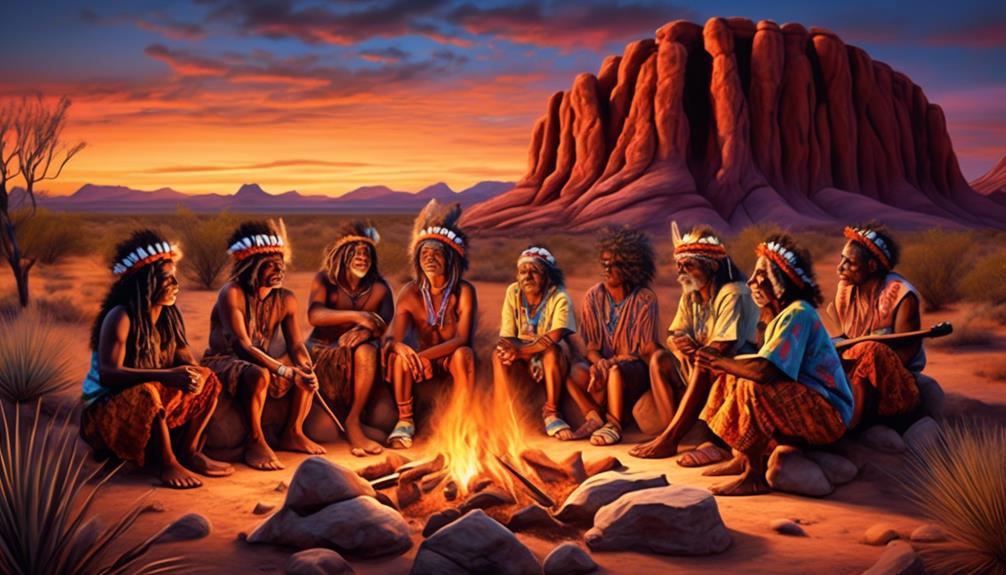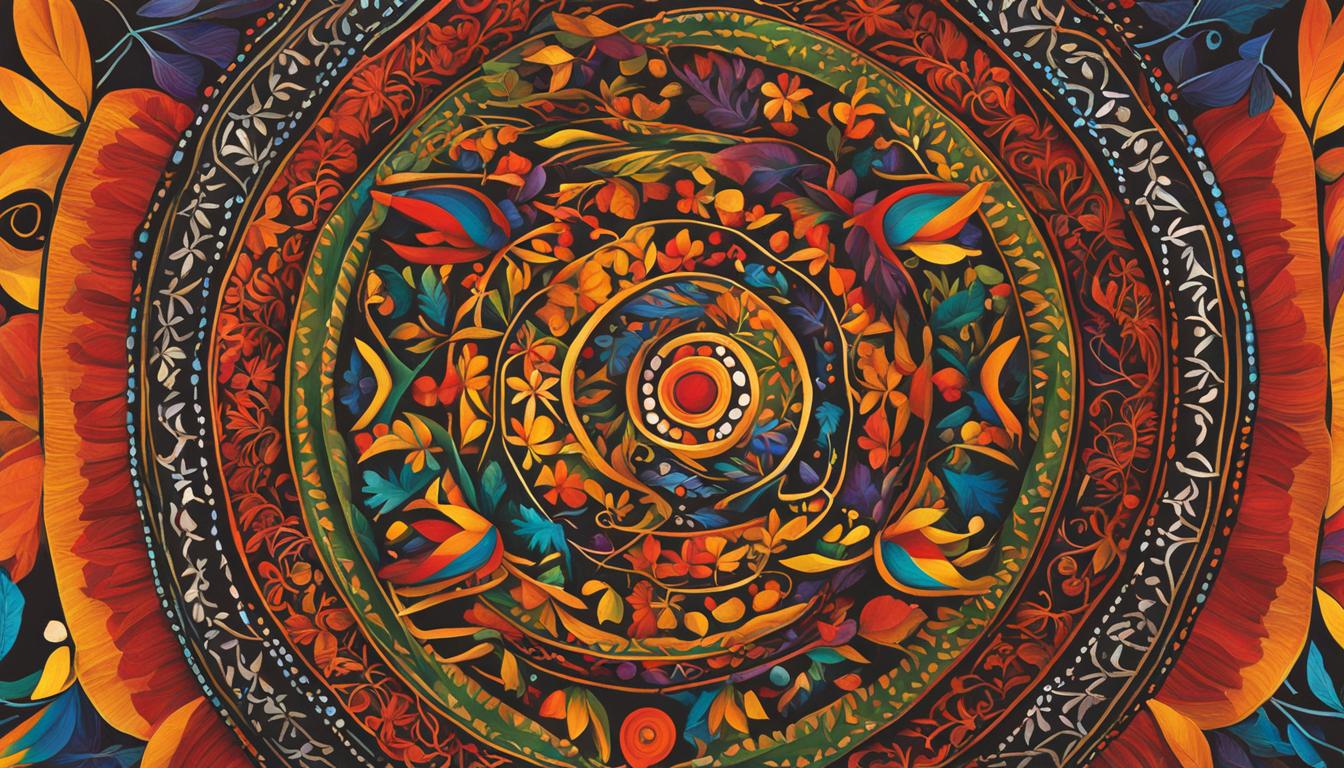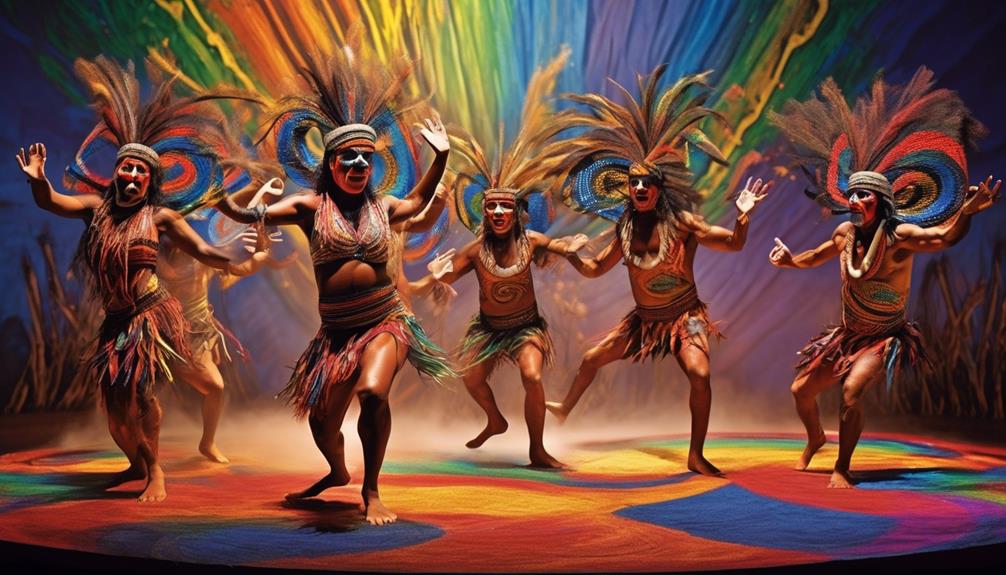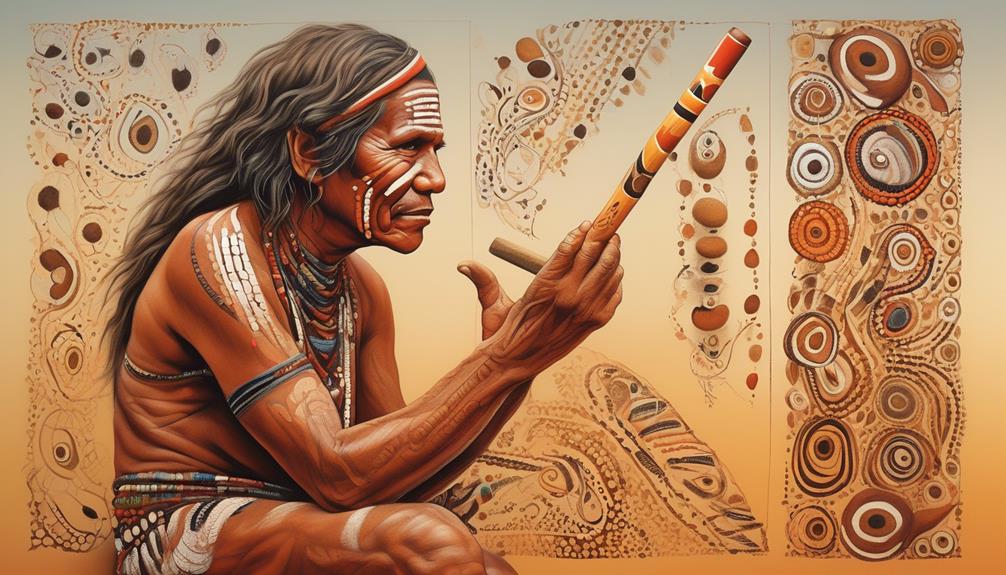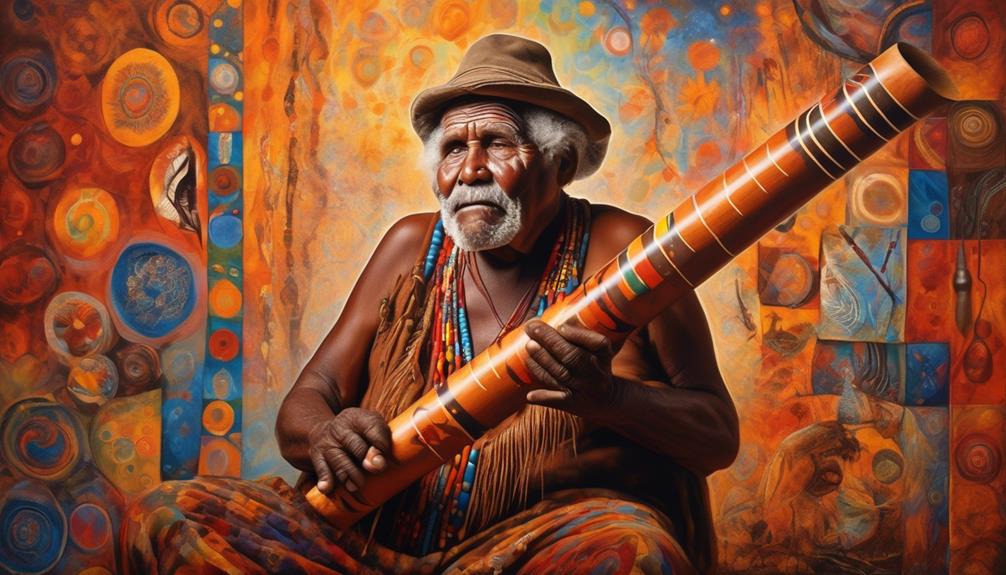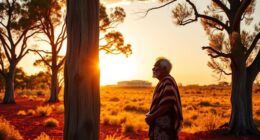Exploring the diverse cultures around the world, one cannot help but be intrigued by the rich history and traditions of Indigenous Australians. Their strong connection to the land and the captivating Dreamtime stories passed down through generations are truly fascinating.
However, the impact of colonization and the ongoing struggle for political representation and recognition of rights have brought about significant challenges for this community. Despite these obstacles, the resilience and activism of Native Australians continue to shape their cultural identity and influence the broader Australian society.
Key Takeaways
- Aboriginal and Torres Strait Islander peoples have a long history in Australia, with evidence suggesting they arrived around 65,000 years ago.
- Migration patterns are deeply connected to the land, sea, and environment, shaping traditional practices and connections to Country.
- The imposition of Western values and practices has eroded traditional cultural identity, but efforts are being made to preserve and revitalize cultural identity within Indigenous communities.
- The forced removal of Indigenous children from their families and communities during the Stolen Generations has had a lasting impact on cultural identity, and addressing the wounds caused by this period is crucial for healing and reconciliation.
Origins and Migration
The diverse Aboriginal and Torres Strait Islander peoples of Australia have a rich and complex history of origins and migration that predates recorded human history.
The origins debate surrounding Indigenous Australians is a contentious and sensitive topic. It involves discussions about the timing of their arrival in Australia, which is a subject of ongoing research and dialogue among scholars, scientists, and Indigenous communities. One prevalent theory suggests that the first inhabitants arrived around 65,000 years ago, challenging previous notions of when humans migrated out of Africa. The evidence for this early migration includes archaeological findings and genetic studies, which have provided valuable insights into the deep roots of Indigenous Australian cultures.
Migration patterns of the Aboriginal and Torres Strait Islander peoples are deeply interconnected with the land, sea, and environment. These patterns are integral to their spiritual and cultural identities, shaping their traditional practices and connections to Country. The concept of 'Country' encompasses not only the physical land but also the spiritual and cultural relationship that Indigenous Australians have with their ancestral territories. The intricate knowledge of the land and sea, passed down through generations, reflects the enduring connection to place and the wisdom derived from sustained interactions with the environment.
Understanding the origins and migration of Indigenous Australians requires a respectful and inclusive approach that centers Indigenous voices and perspectives. It's essential to acknowledge the complexities and diversity of Indigenous cultures and histories, honoring the resilience and continued presence of the world's oldest living cultures.
Traditional Cultural Practices
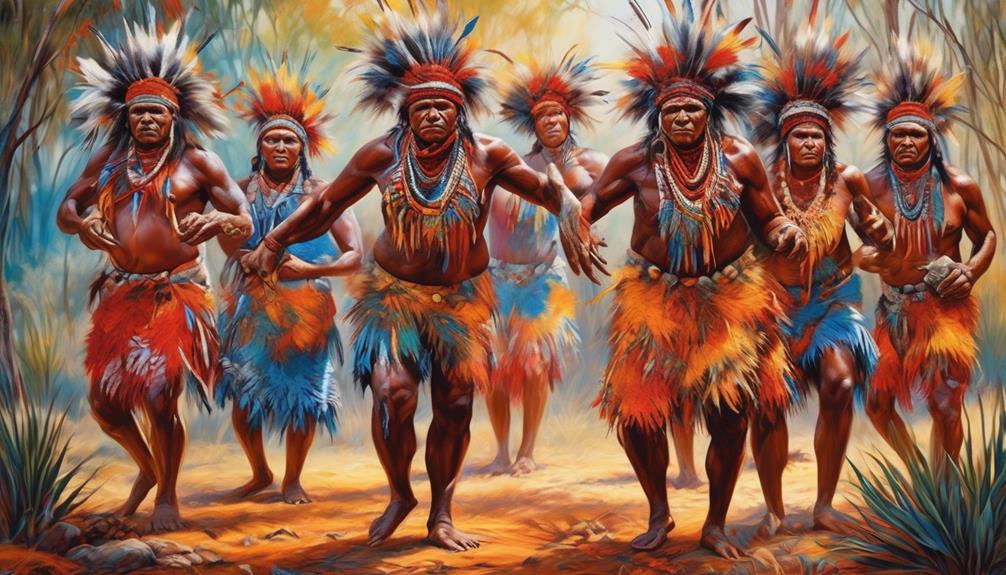
Deeply rooted in our ancestral connection to Country, traditional cultural practices are integral to the identity and resilience of Indigenous Australian peoples. These practices are a living expression of our continual relationship with the land, passed down through generations, and remain an essential part of our contemporary existence.
- Traditional Ceremonies: Our ceremonies are sacred and mark significant events, such as initiation, marriage, and seasonal changes. They connect us to our ancestors and the spiritual essence of Country, fostering a sense of belonging and continuity.
- Storytelling Traditions: Storytelling is a fundamental way of sharing knowledge, history, and spiritual beliefs. Through oral narratives, we uphold our cultural values and teachings, preserving the wisdom of our elders for future generations.
- Cultural Dance and Traditional Art: Dance is a powerful medium for expressing cultural stories, connections to the land, and spiritual beliefs. Each movement holds deep symbolic meaning, reflecting our intimate relationship with the natural world. Similarly, traditional art forms, such as dot painting and carving, carry the essence of our cultural heritage, depicting Dreaming stories and the interconnectedness of all living things.
These practices aren't relics of the past but are vital components of our contemporary Indigenous identity. Embracing and perpetuating these traditions is a testament to our strength, resilience, and unwavering connection to the land, which sustains and nourishes us.
Dreamtime Stories and Beliefs
Engaging in Dreamtime storytelling and embracing traditional beliefs is an essential aspect of our cultural heritage, fostering a deep connection to our ancestral wisdom and spiritual understanding. Dreamtime stories hold immense cultural significance for us as Native Australians. These stories aren't just myths or legends; they form the foundation of our spiritual beliefs and provide a profound understanding of the world around us. Through these stories, we learn about the creation of the land, the animals, and our people, as well as the moral lessons and values that guide our lives.
Our storytelling traditions are passed down through generations, preserving the knowledge and wisdom of our ancestors. These stories aren't merely entertainment; they're sacred narratives that connect us to our past, present, and future. Each story is a thread woven into the rich tapestry of our cultural identity.
The Dreamtime stories aren't confined to a distant past; they exist in an ongoing present, shaping our understanding of the world and our place within it. They remind us of our responsibilities to the land, the spirits, and each other. By sharing these stories, we not only preserve our cultural heritage but also invite others to appreciate the depth of our spiritual beliefs and the interconnectedness of all life. This exchange of knowledge and understanding is essential for the liberation of all peoples, fostering respect and appreciation for diverse worldviews.
Impact of Colonization

Colonization has significantly impacted our traditional way of life, reshaping our cultural practices and challenging the preservation of our ancestral knowledge. The impact of colonization on Native Australians is profound, affecting every aspect of our existence. Here are some key points to consider:
- Cultural Assimilation
- The imposition of Western values and practices has led to the erosion of our traditional cultural identity. The pressure to conform to Western norms has resulted in the loss of unique customs and spiritual beliefs, threatening the very essence of our cultural heritage.
- The forced assimilation into European ways of life has created a sense of displacement and disconnection from our own traditions, causing internal conflicts as we strive to navigate between our indigenous roots and the dominant culture.
- Identity Preservation
- Despite the challenges posed by colonization, there's a resilient effort within our communities to preserve and revitalize our cultural identity. This includes reclaiming traditional languages, reviving ancient ceremonies, and promoting indigenous art forms as a means of asserting our unique cultural presence.
- Traditional Knowledge Revitalization
- The intergenerational transmission of traditional knowledge has been disrupted due to the impact of colonization. Efforts are underway to reclaim and revitalize this knowledge, ensuring that our ancestral wisdom and practices aren't lost to future generations.
As Native Australians, navigating the impact of colonization is an ongoing journey towards reclaiming our cultural autonomy and revitalizing our ancestral heritage.
Stolen Generations
The impact of colonization has deeply affected our communities, and one of the most distressing consequences is the era known as the Stolen Generations. This dark period in our history refers to the forced removal of Indigenous children from their families and communities by government agencies and church missions. The trauma inflicted during this time continues to reverberate through generations, leading to what we call intergenerational trauma. The pain and suffering of those who were taken, as well as their families, have had a lasting impact on our people, affecting our cultural identity, connection to land, and spiritual well-being.
However, despite this painful history, our communities are resilient and committed to healing and reconciliation. We're actively engaged in addressing the deep wounds caused by the Stolen Generations. Through cultural revitalization programs, community healing initiatives, and advocacy for truth and justice, we're working towards healing the scars of the past.
Furthermore, the process of reconciliation is ongoing, as we strive to rebuild trust and create a more inclusive and equitable future for all Australians. This journey towards healing and reconciliation is a collective effort that involves acknowledging past wrongs, fostering understanding, and creating avenues for redress and healing. It's through these efforts that we hope to create a more just and compassionate society for future generations.
Land Rights and Sovereignty
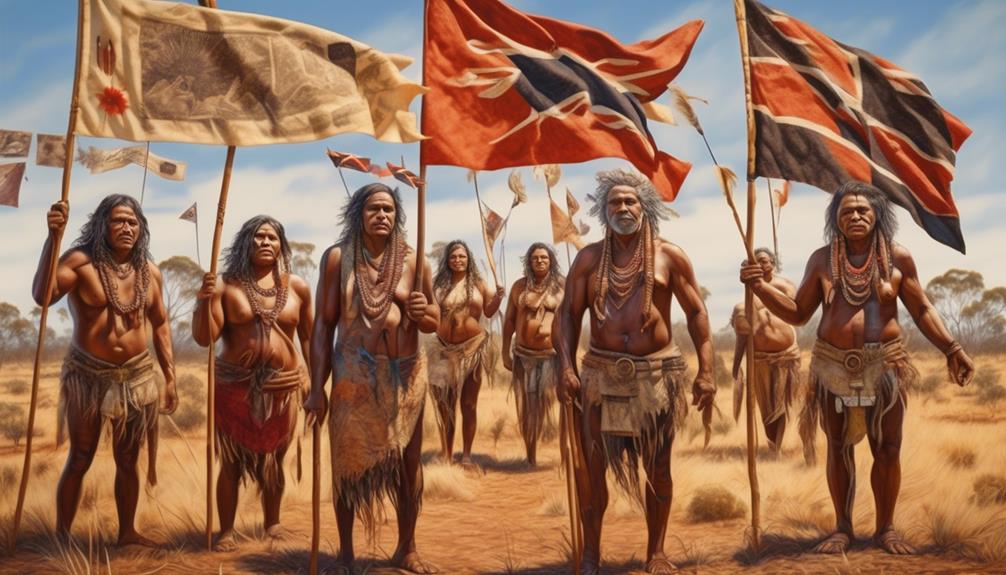
Asserting our rights to land and sovereignty is a crucial aspect of preserving our cultural heritage and ensuring the well-being of future generations. Our connection to the land is deeply rooted in our identity, spirituality, and traditions. As Indigenous Australians, the struggle for land rights and sovereignty has been central to our ongoing journey of cultural revival and resilience.
- Preservation of Traditional Land Stewardship
- Our ancestral lands hold profound spiritual and cultural significance, and it's our inherent responsibility to protect and nurture these sacred spaces.
- Through the recognition of our traditional land stewardship practices, we aim to ensure sustainable management of natural resources, honoring the wisdom passed down through generations.
- By reclaiming our rights to traditional lands, we're reclaiming our ability to practice our cultural traditions and maintain our spiritual connections to the land.
- Sovereignty and Self-Determination
- Sovereignty empowers us to govern our own affairs, make decisions that affect our communities, and revitalize our languages, customs, and legal systems.
- Upholding our sovereignty is essential for the preservation of our unique cultural identities and the autonomy to shape our collective future.
- Through the assertion of our sovereignty, we seek to create pathways for self-determination, allowing us to address the social, economic, and political challenges faced by our communities.
- Cultural Revival and Well-being
- Restoring our rights to the land is foundational to the revival and preservation of our cultural practices, languages, and knowledge systems.
- The recognition of our land rights contributes to the well-being of our communities, fostering pride, resilience, and a sense of belonging.
- As we continue to assert our land rights and sovereignty, we envision a future where our cultural heritage thrives, and our future generations can flourish in harmony with the land.
Contemporary Challenges
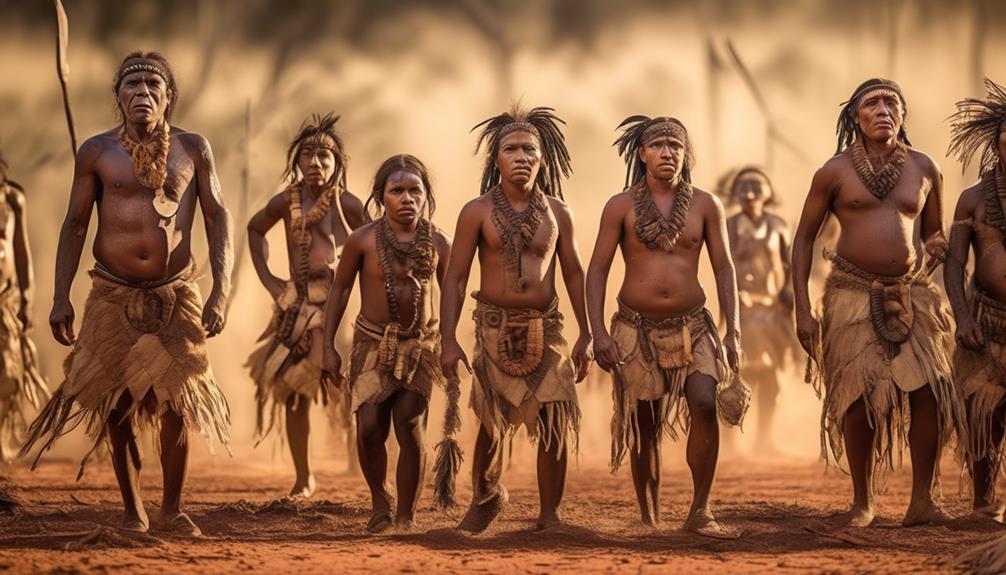
Facing contemporary challenges, we strive to address the complex issues that impact our communities, seeking sustainable solutions rooted in our cultural resilience and collective strength.
Intergenerational trauma continues to cast a long shadow over our people, stemming from historical injustices and ongoing systemic marginalization. Its impact is deeply felt, manifesting in mental health disparities, substance abuse, and family breakdowns. We're committed to addressing this trauma by fostering culturally sensitive healing practices and providing accessible mental health support to our community members.
Moreover, social inequality remains a pervasive issue, perpetuating disparities in health, education, and employment. We're actively engaging in advocacy efforts to dismantle structural barriers and promote equitable access to resources. By amplifying our voices and advocating for policy reforms, we aim to create pathways for our youth to thrive and contribute to our collective prosperity.
In navigating these contemporary challenges, we draw strength from the wisdom of our elders and the resilience of our ancestors. We're harnessing our cultural traditions and knowledge systems to guide us in finding holistic solutions that honor the interconnectedness of all aspects of our lives.
Through community-led initiatives and partnerships, we're fostering sustainable change that uplifts our people and ensures a future where our cultural heritage flourishes, and our communities thrive.
Cultural Revival and Preservation

Navigating the complexities of contemporary challenges, we're actively revitalizing and preserving our cultural heritage to ensure its enduring legacy within our communities. This ongoing endeavor is crucial in maintaining the richness and diversity of our traditions, enabling us to pass down our ancestral wisdom to future generations. As we engage in the cultural revival and preservation, we recognize the significance of traditional knowledge and practices in shaping our identity and fostering a sense of belonging.
- Celebrating Our Heritage: Embracing our cultural revival involves organizing vibrant festivals and gatherings that showcase our traditional music, dance, art, and storytelling. By inviting people from diverse backgrounds to participate, we foster understanding and appreciation for our heritage.
- Transmitting Ancestral Wisdom: We're committed to preserving our traditional knowledge by documenting oral histories, teachings, and rituals. Through educational programs and workshops, we aim to impart this wisdom to our youth, ensuring the continuity of our cultural practices.
- Safeguarding Sacred Sites: We're dedicated to protecting our sacred landscapes and significant sites, which hold deep spiritual and cultural importance. By advocating for their conservation and promoting sustainable practices, we honor our connection to the land and its role in our cultural revival.
In our pursuit of cultural revival and preservation, we invite all who share our commitment to join us in safeguarding the legacy of our ancestors and nurturing the cultural vitality of our communities.
Contributions to Australian Society
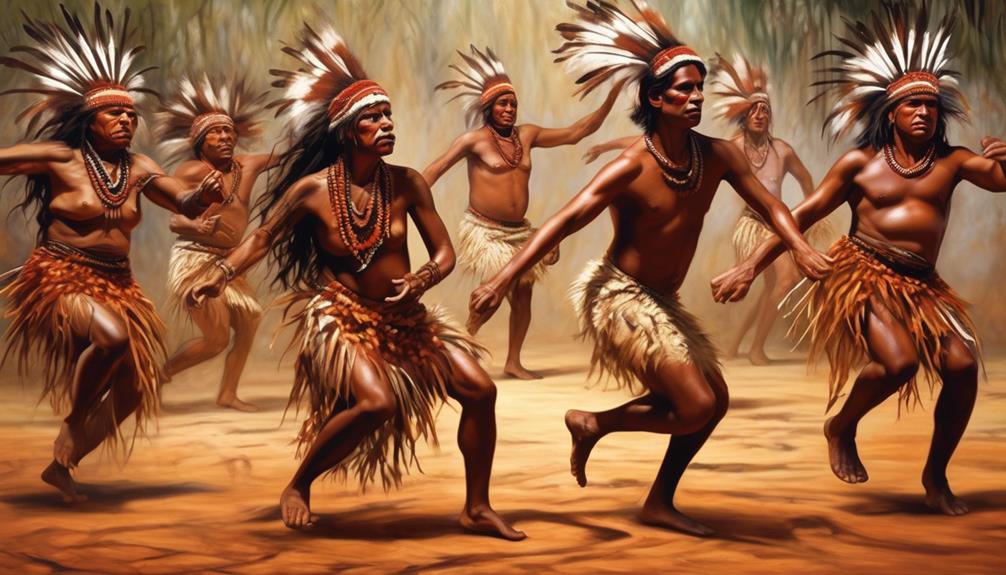
As we explore the contributions of Native Australians to Australian society, we see the profound impact of their art and music, which serve as a vibrant expression of their cultural identity.
Additionally, their traditional medicine practices have influenced healthcare approaches, offering valuable insights into holistic wellness.
Furthermore, their deep connection to the land has led to sustainable stewardship practices that benefit not only their communities but also the wider Australian society.
Art and Music
Throughout history, indigenous Australians have made significant contributions to Australian society through their art and music. Indigenous art reflects a deep connection to the land, using traditional techniques and symbols to convey stories of cultural significance.
Traditional music, passed down through generations, continues to be an integral part of indigenous ceremonies and rituals, carrying the essence of their spirituality and heritage.
These artistic expressions serve as a way of preserving and sharing their rich cultural traditions with the wider Australian community. Indigenous art and music not only contribute to the diversity of Australian culture but also challenge mainstream perceptions, fostering a deeper understanding and appreciation of the indigenous experience.
It's through these artistic forms that indigenous Australians continue to assert their presence and resilience in the face of historical and ongoing challenges.
Traditional Medicine
Traditional medicine has been an integral part of indigenous Australian society, embodying centuries of knowledge and practices that have contributed significantly to the broader Australian healthcare landscape.
Herbal remedies, healing practices, traditional knowledge, and plant medicine are core components of traditional Aboriginal healthcare. These healing methods are rooted in a deep understanding of the land, seasons, and the interconnectedness of all living beings.
Traditional healers, often referred to as Ngangkari, hold profound knowledge of the healing properties of various plants and the intricate ways to administer them for different ailments.
The use of traditional medicine isn't just about physical health but also encompasses spiritual and emotional well-being. It's important to recognize the value of these ancient healing practices and work towards integrating them into the broader healthcare system, respecting the wisdom and expertise of indigenous healers.
Land Stewardship
We, as indigenous Australians, have been entrusted with the vital responsibility of nurturing and safeguarding the land, drawing upon our deep connection to the earth and its natural rhythms to contribute to the well-being of Australian society.
Our sustainable practices and environmental stewardship are rooted in our profound respect for the land, passed down through generations. Through sustainable land management, we strive to maintain a delicate balance between human needs and the preservation of the natural environment.
Our holistic approach to environmental stewardship involves not only conserving the land but also sharing our traditional ecological knowledge with the wider community. By integrating sustainable practices into modern society, we aim to foster a harmonious relationship between humans and the land, ensuring the well-being of all living beings for generations to come.
Indigenous Art and Music
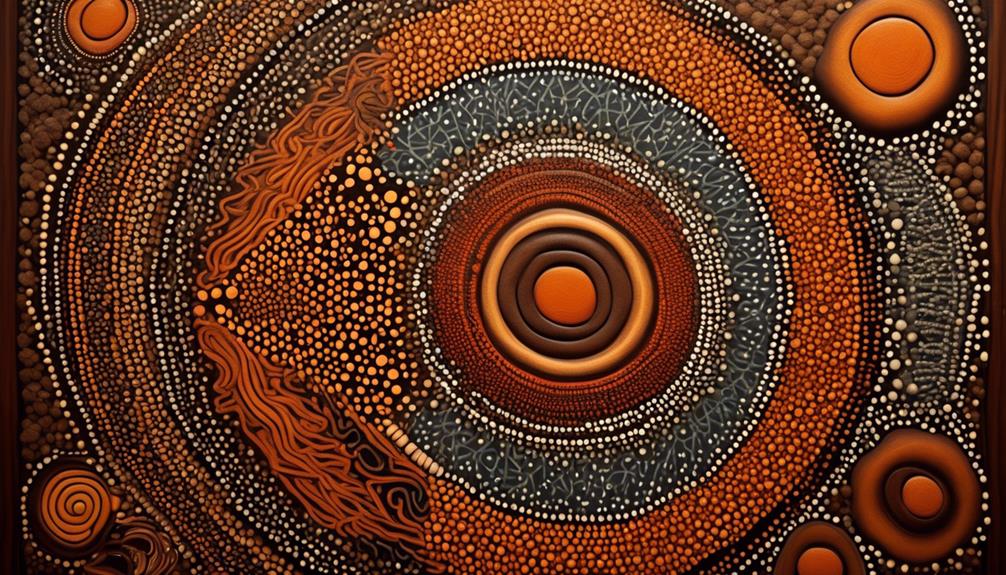
Over the centuries, Indigenous Australians have developed a rich and diverse tradition of art and music that reflects our deep connection to the land and our cultural heritage. Indigenous storytelling and dance are integral parts of our artistic expression, serving as powerful vehicles for passing down knowledge, traditions, and spiritual beliefs from one generation to another. These stories and dances encapsulate our intimate relationship with the land, animals, and the cosmos, embodying our collective wisdom and identity.
Traditional instruments such as the didgeridoo, clapsticks, and bullroarer aren't just musical tools but bearers of profound cultural significance, carrying the essence of our ancestral knowledge and spiritual connection to the land.
Moreover, the concept of songlines holds immense cultural importance for us. These intricate oral maps, woven into songs, describe the landscape, sacred sites, and ancestral stories, serving as a wayfinding tool and preserving our profound connection to the land. It's through songlines that we maintain our cultural memory and navigate the vastness of our ancestral territories.
In our art and music, we find not just creative expressions but a living embodiment of our cultural resilience and resistance. They're the manifestations of our survival, adaptation, and celebration of our identity despite centuries of adversity. Through our art and music, we continue to assert our presence and assert the continuity of our rich cultural heritage.
Health Disparities and Initiatives
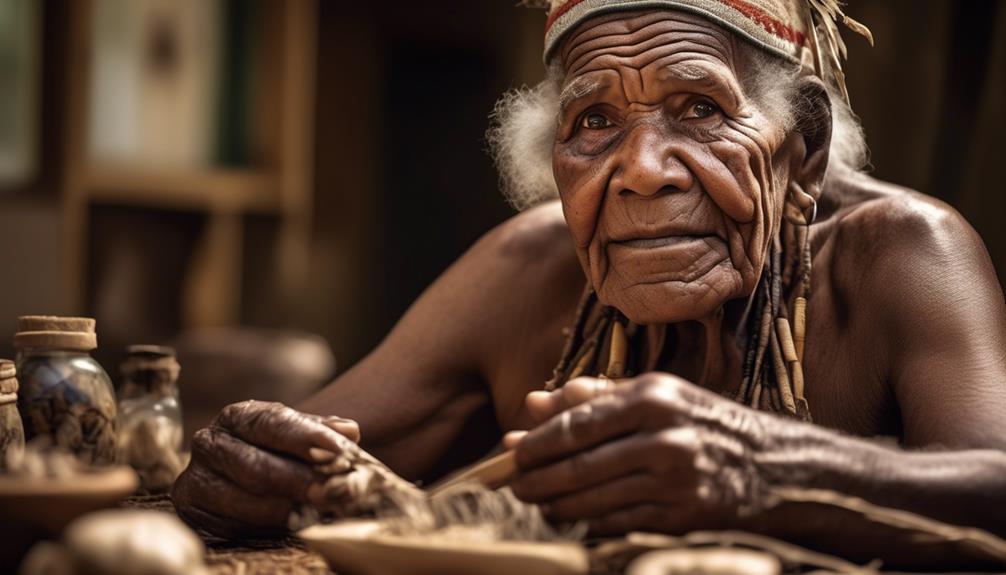
Having explored the rich tradition of art and music that reflects our deep connection to the land and cultural heritage, it's imperative to address the health disparities and initiatives within Indigenous Australian communities.
Our communities face significant health disparities, with higher rates of chronic diseases, mental health issues, and lower life expectancy compared to non-Indigenous Australians. However, there are ongoing community initiatives aimed at addressing these disparities and promoting holistic well-being.
- Challenges in Health Disparities: Our communities often experience barriers to accessing quality healthcare, including geographical remoteness, cultural insensitivity in healthcare services, and socioeconomic disadvantage. These challenges contribute to the disparities in health outcomes experienced by Indigenous Australians.
- Community-Led Initiatives: Many Indigenous communities are taking proactive steps to address these disparities through culturally sensitive healthcare services, community health education programs, and initiatives aimed at promoting healthy lifestyles. These community-led initiatives are crucial in bridging the gap in health outcomes and ensuring that our people receive the care and support they deserve.
- Integration of Traditional Healing and Modern Healthcare: Recognizing the importance of traditional healing practices, there's a growing movement to integrate traditional Indigenous healing methods with modern healthcare approaches. This integration acknowledges the holistic nature of health and the significance of cultural practices in promoting well-being.
In addressing these health disparities and promoting community-led initiatives, we're working towards a future where Indigenous Australians have equal access to quality healthcare and where our cultural approaches to healing are respected and integrated into the healthcare system.
Political Representation and Activism

When it comes to political representation, land rights activism, and cultural preservation efforts, Native Australians have been at the forefront of advocating for their rights and heritage.
We see their efforts in government representation, where Indigenous Australians have been working to ensure their voices are heard in decision-making processes.
Additionally, the ongoing activism for land rights and cultural preservation reflects the deep commitment to maintaining their traditions and connection to the land.
Government Representation
Native Australians actively engage in political representation and activism to advocate for their rights and interests within the government. This involvement is crucial for shaping policies that address the unique challenges faced by Indigenous communities.
Here are some ways in which Native Australians are participating in government representation and indigenous activism:
- Lobbying for legislative changes that recognize and protect Indigenous land rights
- Engaging in grassroots campaigns to raise awareness about issues affecting Indigenous communities
- Utilizing legal avenues to challenge discriminatory policies and seek redress for historical injustices
Through these efforts, Native Australians are working to ensure that their voices are heard in the political sphere and that the government upholds their rights and respects their cultural heritage.
Land Rights Activism
Engaging in grassroots campaigns and legal advocacy, we, as Native Australians, actively pursue land rights activism to secure recognition and protection of our ancestral lands.
Our efforts are rooted in the fundamental principle of indigenous sovereignty, asserting our right to govern our traditional territories.
Through alliances with non-Indigenous supporters and international solidarity networks, we strive to challenge discriminatory land policies and seek restitution for historical injustices.
By amplifying our voices in the political arena, we demand meaningful participation in decision-making processes that affect our lands.
Our activism isn't only about legal battles but also about fostering a deeper understanding of our spiritual and cultural connection to the land.
We're committed to creating a future where our rights as custodians of the land are respected and upheld.
Cultural Preservation Efforts
As custodians of our ancestral lands, we continue our advocacy for cultural preservation through active political representation and grassroots activism. Our efforts are centered around cultural revitalization and heritage preservation, aiming to ensure the survival and thriving of our traditional ways of life.
To achieve this, we engage in the following strategies:
- Political Engagement: We actively participate in local and national politics, advocating for policies that recognize and protect our cultural heritage.
- Community Empowerment: Through grassroots activism, we empower our communities to take ownership of cultural preservation efforts, fostering a sense of pride and responsibility for our traditions.
- Inter-Generational Education: We prioritize passing down traditional knowledge and practices to younger generations, ensuring the continuity of our cultural heritage for years to come.
Connection to the Land

With a deep and enduring bond, indigenous Australians have maintained a profound connection to the land for countless generations. Our connection to the land is rooted in traditional ecological knowledge, which encompasses a deep understanding of the environment, sustainable practices, and environmental stewardship. This connection is central to our cultural identity and shapes our way of life, guiding our interactions with the natural world.
| Traditional Ecological Knowledge | Sustainable Practices | Environmental Stewardship |
|---|---|---|
| Indigenous Australians possess a wealth of traditional ecological knowledge, passed down through generations, which includes an intimate understanding of the land, its resources, and the delicate balance of ecosystems. | Sustainable practices such as controlled burning, hunting and gathering techniques, and land management strategies have been honed over millennia, ensuring the preservation of the land and its resources for future generations. | Environmental stewardship is inherent in indigenous Australian cultures, as we view ourselves as custodians of the land, with a responsibility to protect and nurture the environment for the well-being of all living beings. |
Our sustainable practices are deeply intertwined with our cultural and spiritual beliefs, reflecting a profound respect for the land and all its inhabitants. Through our connection to the land, we strive to maintain harmony and balance, fostering a sustainable coexistence with nature. It is our hope that by sharing our traditional ecological knowledge and sustainable practices, we can contribute to a broader movement of environmental stewardship and conservation, honoring the interconnectedness of all life on Earth.
Language and Linguistic Diversity
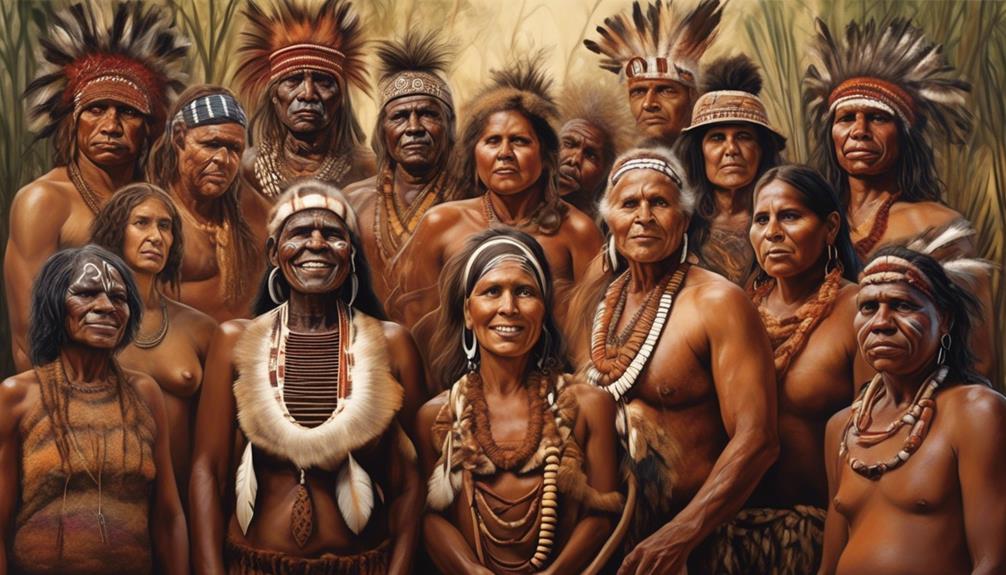
Our discussion on Native Australians can't be complete without acknowledging the rich tapestry of languages and linguistic diversity among Indigenous communities.
Language preservation efforts are vital in maintaining the cultural significance of these diverse languages, as they're deeply intertwined with the identity and heritage of Indigenous peoples.
The impact of language loss goes beyond communication; it shapes worldviews, knowledge systems, and social structures, highlighting the profound importance of linguistic diversity in Indigenous communities.
Language Preservation Efforts
Efforts to preserve the languages of Native Australians are crucial for maintaining their cultural heritage and promoting linguistic diversity. As we delve into the realm of language preservation, it's essential to understand the multifaceted strategies and community-driven initiatives that play a pivotal role in reviving and safeguarding Indigenous languages.
- Language Revitalization
Engaging community members in language revitalization programs fosters a sense of pride and belonging, empowering them to reclaim their linguistic identity.
- Preservation Strategies
Implementing comprehensive documentation techniques and developing educational resources are vital for preserving endangered languages and ensuring their survival.
- Intergenerational Transmission
Encouraging intergenerational transmission of language through family-based initiatives and educational curriculum integration reinforces the continuity of Indigenous languages within their communities.
Cultural Significance of Language
The preservation of Indigenous languages is integral to honoring the rich cultural heritage and promoting linguistic diversity within Native Australian communities. Language preservation isn't solely about words; it embodies cultural identity, traditions, and a profound connection to the land.
Each language reflects a distinctive way of understanding the world, encompassing unique knowledge systems and philosophies. When Indigenous languages thrive, linguistic diversity flourishes, contributing to the tapestry of human expression. Celebrating this linguistic diversity is essential for the preservation of heritage and the promotion of cultural resilience.
The revival and maintenance of Indigenous languages are acts of empowerment, reclaiming and reaffirming the value of traditional knowledge. By embracing and supporting the continued use of Indigenous languages, we actively participate in honoring and preserving the cultural legacy of Native Australians.
Impact on Identity
Embracing and preserving the diverse Indigenous languages of Native Australians is essential for cultivating a strong sense of cultural identity and fostering a deep connection to ancestral traditions. Our languages are repositories of our cultural heritage, carrying stories, knowledge, and spiritual beliefs that shape our collective identity. Their preservation is crucial in reclaiming and reaffirming our place in the world.
- Linguistic Diversity: Each Indigenous language reflects unique cultural perspectives and ways of understanding the world.
- *Cultural Revitalization*: Reviving and promoting our languages is an act of resistance against historical injustices and ongoing discrimination.
- *Empowerment*: Speaking our languages empowers us, contributing to our social justice and liberation movements.
- *Interconnectedness*: Our languages strengthen our bonds and connections with each other, fostering a sense of community and solidarity.
Celebrating Indigenous Heritage

Celebrating Indigenous heritage involves acknowledging the rich cultural traditions and history of Australia's First Nations peoples. It's a powerful way to honor and preserve the diverse practices and customs that have been passed down through generations. Through cultural heritage revival, we are able to celebrate traditions that have withstood the test of time, and continue to be integral to the identity and resilience of Indigenous communities.
| Traditions | Description | Significance |
|---|---|---|
| Dreamtime Stories | Oral histories and spiritual beliefs of creation and existence. | Connects people to the land and teaches moral lessons. |
| Didgeridoo | Traditional Aboriginal wind instrument. | Symbolizes cultural identity and is used in ceremonial practices. |
| Bush Tucker | Indigenous food gathering and preparation methods. | Sustains connection to the land and promotes environmental stewardship. |
| Aboriginal Art | Diverse forms of artistic expression including rock paintings and dot paintings. | Preserves cultural knowledge and serves as a means of storytelling. |
These traditions are not just relics of the past; they are living, breathing aspects of Indigenous culture. It's essential for us to recognize the value of these traditions and actively support their preservation and continuation. By participating in and promoting the celebration of Indigenous heritage, we can contribute to the empowerment and self-determination of First Nations peoples. It's a way of acknowledging the resilience and strength of Indigenous communities, and embracing the richness of Australia's cultural tapestry.
Frequently Asked Questions
What Are the Traditional Methods of Healing and Medicine Used by Native Australians?
Traditional healing methods often involve herbal remedies, cultural practices, and spiritual healing.
Traditional medicine often includes holistic healing techniques that focus on the interconnectedness of the mind, body, and spirit.
These methods have been passed down through generations and are deeply rooted in our cultural heritage.
They offer a holistic approach to health and well-being, addressing not only physical ailments but also emotional and spiritual needs.
How Do Native Australians Celebrate and Preserve Their Cultural Heritage Through Traditional Ceremonies and Festivals?
We celebrate and preserve our cultural heritage through traditional ceremonies and festivals. These events honor our ancestors, strengthen community bonds, and pass down our customs to future generations.
By participating in these rituals, we maintain our connection to the land, revitalize our language, and showcase our scientific contributions and technological innovations.
Through these celebrations, we continue to heal and thrive, embracing our Indigenous identity with pride and resilience.
What Are the Current Efforts to Revitalize and Preserve the Diverse Languages of Native Australian Tribes?
We are making concerted efforts to revitalize and preserve the diverse languages of native Australian tribes. These efforts are crucial in preserving cultural heritage and maintaining a strong connection to the land.
By prioritizing language revitalization, we honor and respect the traditions of our ancestors, ensuring that their voices and stories continue to be heard for generations to come.
These initiatives are vital in preserving the richness and diversity of our linguistic heritage.
How Do Native Australians Maintain a Connection to the Land and Natural Environment in Their Daily Lives?
Maintaining a deep connection to the land is essential for many indigenous communities worldwide.
In our case, Native Australians have sustained their ties to the natural environment through traditional practices and knowledge.
This connection fosters environmental sustainability and supports holistic wellness.
For example, our community's traditional healing methods often involve utilizing plants and natural resources from the land, highlighting the interconnectedness between our health and the environment.
What Are the Unique Contributions of Native Australians to the Fields of Science, Technology, and Innovation in Australian Society?
Innovation is a key driver of progress in society. Our contributions in science and technology have advanced various fields, shaping the world we live in.
Our unique perspectives and insights have fueled groundbreaking research and education initiatives, leading to valuable technological advancements.
Our culture has inspired new approaches and solutions, enriching the fabric of society.
We continue to make significant impacts, fostering innovation and progress in Australian society.
Conclusion
In conclusion, we've explored the rich and diverse culture of native Australians, learning about their origins, traditional practices, and the impact of colonization.
While some may argue that the Stolen Generations are in the past, it's important to recognize that the effects still impact indigenous communities today.
By celebrating and respecting their heritage, we can work towards a more inclusive and equitable society for all Australians.
